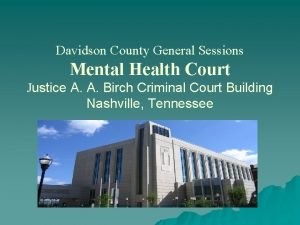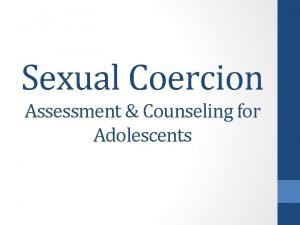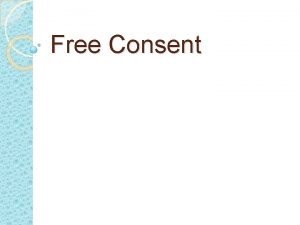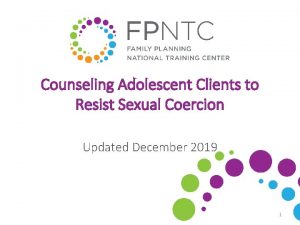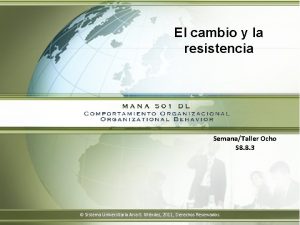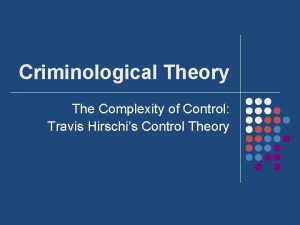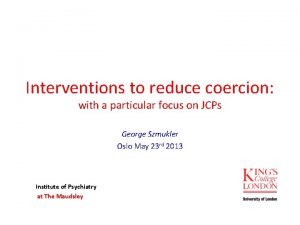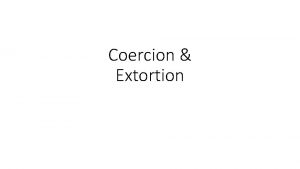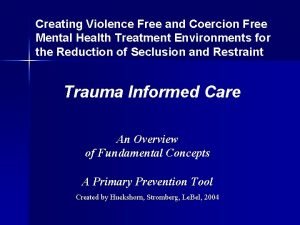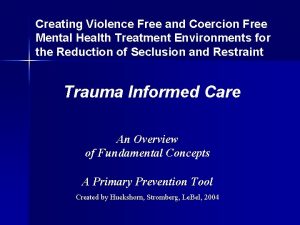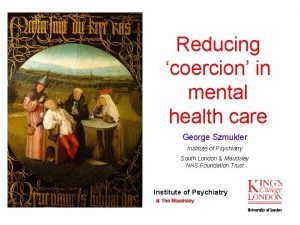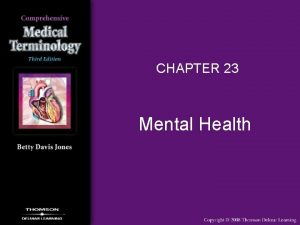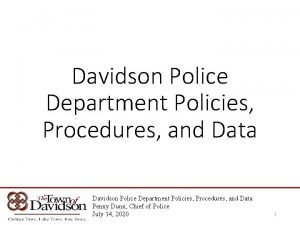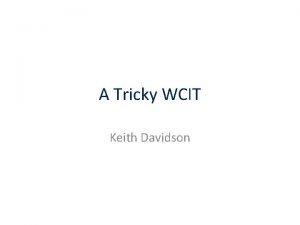COERCION AND MENTAL HEALTH Gavin Davidson Senior Lecturer





















- Slides: 21

COERCION AND MENTAL HEALTH Gavin Davidson Senior Lecturer in Social Work Queen’s University Belfast Northern Ireland g. davidson@qub. ac. uk

CONTEXT OF NORTHERN IRELAND

OVERVIEW OF THE PRESENTATION What is the issue? Rationale for coercion Forms of coercion in mental health services When should coercion be used? Does it work? Is it necessary? What are the alternative approaches?

WHAT IS THE ISSUE? One of the most concerning aspects of mental health intervention is the use of compulsion – it is potentially traumatising and the evidence base for its effectiveness is contested. Coercion can be thought of as the internal subjective experience of being forced, with external processes, such as compulsory intervention, making that much more likely (Newton-Howes, 2010) and also the practice of forcing someone against their will Under some mental health laws it is possible to detain and/or force treatment on someone who, although unwell, has the relevant mental capacity or decision making ability to consent to or refuse intervention – this is discriminatory It may always be necessary and important for the state to intervene to protect people who lack the relevant decision making ability - there is an urgent need for a greater emphasis on trying to minimise coercion by supporting people to make their own decisions, developing alternatives to compulsion and considering the criteria for

WHAT IS THE ISSUE? 1873) John Stuart Mill (1806 -

WHAT IS THE ISSUE? Educated by his father, James Mill, and Jeremy Bentham (Utilitarianism), in what they thought was in his (and their) best interests – learnt Greek at 3, Latin at 8, politics and economics at 13. Became depressed aged 20 – ‘A crisis in my mental history’ On Liberty (1859) - social tyranny or the tyranny of the majority

WHAT IS THE ISSUE? “…the only purpose for which power can be rightfully exercised over any member of a civilized community, against his will, is to prevent harm to others. His own good, either physical or moral, is not a sufficient warrant… It is, perhaps, hardly necessary to say that this doctrine is meant to apply only to human beings in the maturity of their faculties…Those who are still in a state to require being taken care of by others, must be protected against their own actions as well as against external injury. ” Principle of autonomy – central to being free/human/happy

RATIONALE FOR COERCION Public safety in a liberal state and paternalism when someone’s ability to make decisions is impaired (Wertheimer, 1993) “The justification for the use of coercion is basically a belief that coercion works, meaning that compulsory treatment improves the outcome compared to the outcome with no (coercive) intervention…the moral obligation to reduce suffering also plays an important role in justifying the use of coercion” (Hoyer et al. , 2002, p. 93) Rights based arguments – sometimes it is necessary to infringe right to liberty in order to protect the right to life Ethics based arguments – we have a duty to intervene to protect people from themselves and others if they are not able to make the relevant decisions Evidence based arguments – the use of coercion can be effective in preventing harm and so the benefits usually outweigh the risks/harm of intervention

FORMS OF COERCION IN MENTAL HEALTH SERVICES Continuum from physical force and compulsory treatment, through pressure and bargaining, to persuasion and the use of self (O’Brien and Golding, 2003; Newton. Howes, 2010) Important distinction between compulsory legal powers and the experience of coercion which may be much broader. Newton-Howes and Stanley (2012)’s review of studies of inpatients found prevalence of perceived coercion ranging from 16 to 90% and that a quarter of legally detained patients did not feel coerced into psychiatric care, whereas a quarter of voluntary in-patients reported coercion in care Coercive strategies are also very commonly used across settings. Therapeutic Limit Setting Scale (Neale and Rosenheck, 2000) has five sub-scales covering verbal guidance, contingent withholding, money management, invocation of external authorities and enforced hospitalization. Davidson and Campbell (2007) reported community mental health professionals (n=55) all reported using at least one of these strategies at all three points in time (over 18 months) confirming Monahan et al. ’s (2005) view that the use of leverage in community mental health services is

FORMS OF COERCION IN MENTAL HEALTH SERVICES Establishing where support ends and coercion begins is very difficult – they can interact and overlap Engagement strategies – constructive, informative and restrictive (Burns and Firn, 2002) Constructive – befriending; collaborative or user-led agenda; strengths-focused interventions; non-judgemental, nurturing approach; advocacy and empowerment; home or community based interventions; mainstream activities; practical assistance and problem solving; social and recreational activity; assistance with financial and welfare benefits; employment assistance and support; support and problem solving for family and carers; obtaining or preserving accommodation. Informative – assertive outreach; frequent and persistent contact – direct or indirect; regular contact with carers where no direct contact with user; door-stepping; observation of home where access denied; information gathering through others; contact with housing/benefits agencies; contact with family doctor. Restrictive approach – mental health law; control of money/access to resources; Guardianship; Child Welfare System, Criminal Justice System.

WHEN SHOULD COERCION BE USED? “Those who are still in a state to require being taken care of by others, must be protected against their own actions as well as against external injury. ” Mill, 1859 Standard mental health law criteria – mental disorder and risk Mental Health (Northern Ireland) Order 1986 Article 4(2): MENTAL DISORDER - He is suffering from mental disorder of a nature or degree which warrants his detention in a hospital for assessment (or for assessment followed by medical treatment); and RISK - Failure to so detain him would create a substantial likelihood of serious physical harm to himself or to other persons”.

WHEN SHOULD COERCION BE USED? Florida Mental Health Act 1971 (revised 2009) (the Baker Act) Different criteria for involuntary examination, involuntary outpatient services and involuntary inpatient placement. Involuntary inpatient placement: (1) CRITERIA. —A person may be ordered for involuntary inpatient placement for treatment upon a finding of the court by clear and convincing evidence that: (a) He or she has a mental illness and because of his or her mental illness: 1. a. He or she has refused voluntary inpatient placement for treatment after sufficient and conscientious explanation and disclosure of the purpose of inpatient placement for treatment; or b. He or she is unable to determine for himself or herself whether inpatient placement is necessary; and 2. a. He or she is incapable of surviving alone or with the help of willing and responsible family or friends, including available alternative services, and, without treatment, is likely to suffer from neglect or refuse to care for himself or herself, and such neglect or refusal poses a real and present threat of substantial harm to his or her well-being; or b. There is substantial likelihood that in the near future he or she will inflict serious bodily harm on self or others, as evidenced by recent behavior causing, attempting, or threatening such harm; and (b) All available less restrictive treatment alternatives that would offer an opportunity for improvement of his or her condition have been judged to be inappropriate.

WHEN SHOULD COERCION BE USED? Mental disorder and risk criteria Mental disorder criterion - based on the assumption that it is possible to objectively identify and classify this concept in a way that is similar to physical health problems (Kirk et al. , 2013) Mental disorder criterion – in some mental health laws, decision making ability or mental capacity is not included in the criteria and so a person who retains the ability to make the decision about intervention can nonetheless be forced Risk criterion – based on the assumption that it is possible for us to predict the future with a sufficient degree of accuracy to justify restriction or deprivation of liberty again this is contested (Davidson et al. , 2016) – major issue across social services

DOES IT WORK? Very few RCTs Cochrane Review of compulsory community treatment (Kisley and Campbell, 2014) Three studies (2 US and 1 UK) (n = 752 participants) follow-up over 12 months No significant difference in service use, social functioning or quality of life compared with standard voluntary care. People receiving compulsory community treatment were, however, less likely to be victims of violent or non -violent crime. It is unclear whether this benefit is due to the intensity of treatment or its compulsory nature. Short periods of conditional leave may be as effective (or non-effective) as formal compulsory treatment in the community Variation in use of compulsory community treatment between and within countries, for example from 2 per 100, 000 (Ontario, Canada) to 99 per 100, 000 (Victoria, Australia) (O’Brien, 2014)

DOES IT WORK? Compulsory admission – evidence is also very limited Priebe et al. (2009) interviewed 778/1570 at baseline and 396/778 after a year and reported 15% of the total sample had been readmitted involuntarily, and 40% of those who consented to follow-up considered their original admission justified. Lower initial treatment satisfaction, being on benefits, living with others and being of African and/or Caribbean origin were associated with higher involuntary readmission rates. Higher initial treatment satisfaction, poorer initial global functioning and living alone were linked with more positive retrospective views of the admission. Some evidence that most of those who survive serious suicide attempts do not go on to kill themselves (O’Donnell et al. , 1996; Moran, 2005)

DOES IT WORK? Potential negative impact Berry et al. (2013) reviewed 24 studies, published between 1980 and 2011. Reported that studies showed high levels of PTSD resulting from the trauma of symptoms and/or hospitalisation, with prevalence rates for actual PTSD resulting from these traumas varying from 11% to 67% Potential impact on sense of self, relationships with others, engagement with services, issues of stigma, internalised stigma, discrimination and anticipated discrimination There is some evidence that how compulsory powers are used is important to how much the person feels coerced “According clients procedural justice by allowing them voice in their treatment and legal proceedings, treating them with respect, and conducting transparent procedures appear to ameliorate the perception of coercion in a significant percentage of clients who are subject to mandated treatment. ” (Galon and Wineman, 2010)

IS IT NECESSARY? Some form of legal framework is needed to make decisions when a person is unable to make them The mental disorder and risk criteria for compulsory intervention are both problematic Having one legal framework for people with mental health problems and one for everyone else is discriminatory The evidence for the effectiveness of coercion is limited How compulsory powers are used is important to the experience of coercion

WHAT ARE THE ALTERNATIVE APPROACHES? Develop alternatives to coercive interventions Make services rather than the person the focus of the compulsory powers Promote procedural justice Promote supported decision making Consider a legal framework that is non-discriminatory – based on decision making ability as the gateway criterion rather than mental disorder and risk. Sometimes referred to as the fusion approach (Dawson and Szmukler, 2006)

WHAT ARE THE ALTERNATIVE APPROACHES? Bamford Review in Northern Ireland concluded: “having one law for decisions about physical illness and another for mental illness is anomalous, confusing and unjust’ and so “. . . the Review considers that Northern Ireland should take steps to avoid the discrimination, confusion and gaps created by separately devising two separate statutory approaches, but should rather look to creating a comprehensive legislative framework which would be truly principles-based and non-discriminatory. ” Mental Capacity Act Northern Ireland 2016 is to replace the current parallel mental health and mental capacity legal frameworks

WHAT ARE THE ALTERNATIVE APPROACHES? The new Act will apply to all, regardless of the cause of impairment and so there will no longer be a separate mental health law Key principle in Section 1(4) “The person is not to be treated as unable to make a decision for himself or herself about the matter unless all practicable help and support to enable the person to make a decision about the matter have been given without success. ” Ongoing issues: How will the support principle be implemented in practice? Is the fusion approach a positive, non-discriminatory response to the UNCRPD? The new Act only applies to those aged 16 and over. It raises difficult, ethical and societal questions about certain unwise decisions, especially about suicide. What impact will it have on the use of coercion in practice? When will the Act be implemented?

REFERENCES Berry, K. , Ford, S. , Jellicoe-Jones, L. , & Haddock, G. (2013). PTSD symptoms associated with the experiences of psychosis and hospitalisation: A review of the literature. Clinical Psychology Review , 33(4), 526 -538. Burns, T. , & Firn, M. (2002). Assertive outreach in mental health. A Manual for Practitioners. Oxford: Oxford University Press. Davidson, G. , Brophy, L. , & Campbell, J. (2016). Risk, Recovery and Capacity: Competing or Complementary Approaches to Mental Health Social Work. Australian Social Work, 69(2), 158 -168. Davidson, G. , & Campbell, J. (2007). An examination of the use of coercion by assertive outreach and community mental health teams in Northern Ireland. British Journal of Social Work, 37(3), 537 -555. Dawson, J. , & Szmukler, G. (2006). Fusion of mental health and incapacity legislation. British Journal of Psychiatry, 188(6), 504 -509. Galon, P. A. , & Wineman, N. M. (2010). Coercion and procedural justice in psychiatric care: State of the science and implications for nursing. Archives of Psychiatric Nursing, 24(5), 307 -316. Høyer, G. , Kjellin, L. , Engberg, M. , Kaltiala-Heino, R. , Nilstun, T. , Sigurjónsdóttir, M. , & Syse, A. (2002). Paternalism and autonomy: a presentation of a Nordic study on the use of coercion in the mental health care system. International Journal of Law and Psychiatry, 25(2), 93 -108. Kirk, S. A, Gomory, T. , & Cohen, D. (2013). Mad Science: Psychiatric coercion, diagnosis, and drugs. Rutgers, NJ: Transaction Publishers. Kisely, S. R. , & Campbell, L. A. (2014). Compulsory community and involuntary outpatient treatment for people with severe mental disorders. The Cochrane Library. Monahan, J. , Redlich, A. D. , Swanson, J. , Robbins, P. C. , Appelbaum, P. S. , Petrila, J. , . . . & Mc. Niel, D. E. (2005). Use of leverage to improve adherence to psychiatric treatment in the community. Psychiatric Services, 56, 37 -44. Moran, M. (2005) Suicide barrier sought for Golden Gate Bridge. Psychiatric News, April 1, 2005, p 21. Neale, M. S. , & Rosenheck, R. A. (2000). Therapeutic limit setting in an assertive community treatment program. Psychiatric Services, 51(4), 499 -505. Newton-Howes, G. (2010). Coercion in psychiatric care: where are we now, what do we know, where do we go? . The Psychiatrist, 34(6), 217 -220. Newton-Howes, G. , & Stanley, J. (2012). Prevalence of perceived coercion among psychiatric patients: literature review and meta-regression modelling. The Psychiatrist Online, 36(9), 335 -340. O’Brien, A. J. (2014). Community treatment orders in New Zealand: regional variability and international comparisons. Australasian Psychiatry, Vol 22(4) 352– 356. O'Brien, A. J. , & Golding, C. G. (2003). Coercion in mental healthcare: the principle of least coercive care. Journal of Psychiatric and Mental Health Nursing, 10(2), 167 -173. O'Donnell, I. , Farmer, R. , & Catal, J. (1996). Explaining suicide: the views of survivors of serious suicide attempts. British Journal of Psychiatry, 168(6), 780 -786. Priebe, S. , Katsakou, C. , Amos, T. , Leese, M. , Morriss, R. , Rose, D. , . . . & Yeeles, K. (2009). Patients’ views and readmissions 1 year after involuntary hospitalisation. British Journal of Psychiatry, 194(1), 49 -54. Wertheimer, A. (1993). A philosophical examination of coercion for mental health issues. Behavioral Sciences & the Law, 11(3), 239 -258.
 Lecturer's name
Lecturer's name Davidson county mental health court
Davidson county mental health court Mental health and mental illness chapter 20
Mental health and mental illness chapter 20 Mental health jeopardy questions and answers
Mental health jeopardy questions and answers Rules of consent
Rules of consent Concepto de estado
Concepto de estado Cuantos cuadrados hay en la imagen
Cuantos cuadrados hay en la imagen Definicion de coercion
Definicion de coercion Hands v simpson fawcett
Hands v simpson fawcett Sexual coercion meaning
Sexual coercion meaning Tactica de coercion
Tactica de coercion Differential coercion theory
Differential coercion theory Stark
Stark Coercion
Coercion Jeannie watkins
Jeannie watkins Spe distinguished lecturer
Spe distinguished lecturer Good afternoon class
Good afternoon class Photography lecturer
Photography lecturer Lecturer in charge
Lecturer in charge Designation lecturer
Designation lecturer Designation of lecturer
Designation of lecturer Gcwak
Gcwak

